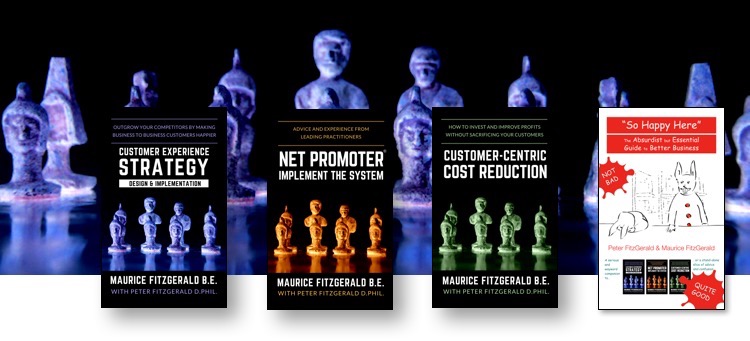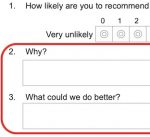#100 – 100th issue – When is it OK not to invest in CX? – NPS blogs – Infographics – 100 ideas
 Welcome to the 100th Customer Strategy newsletter! The five topics this week are:
100 newsletters already?Yes, this is indeed the 100th Customer Strategy newsletter. I started the newsletter, blog, and books with a simple idea in mind: to do a sort of ‘mind dump’, meaning to transfer a lot of knowledge and experience from my brain to electronic and physical media. I imagined that I would then be able to forget about it all and concentrate on being retired. It has not worked out that way. I thought the principle was sound. I started my career in the clothing industry. When I left it, I felt I was an expert in two areas: logistics and stonewashing. Digital Equipment Corporation (DEC) hired me for my logistics skills, so no mind dump was necessary there. However, I felt I had innovated considerably with the various chemical and physical processes involved in washing jeans. When I stopped working for the Wrangler jeans parent company I felt a need to preserve that knowledge. So I wrote it all up, photocopied it, and sent it to my colleagues and to various internal and external laundries and chemical companies with which I had worked. That was in 1985. I can say that I never thought about it all again from that point onwards. My latest mind dump worked as far as my work on cost reduction is concerned. It has not worked out that way for customer experience and I think the reason is clear: we are all constantly surrounded by customer experiences every day. As a professional, it is hard not to observe what is happening and to think about what companies and government institutions could do better. So I keep on writing and posting content, though I feel I have already offered all the original thought that was in my head. For the last six months I believe I mainly reinforce points I have already made, sometimes by commenting on the work of others. Our books continue to do well. June 2019 was the best of the three months of June we have had since launch. I have also been fortunate enough to be asked to speak to live audiences from time to time, and that is quite rewarding. The only work I do from which I don’t get any particular satisfaction is managing the 104,000-member LinkedIn Customer Experience and Artificial Intelligence group. Ever since LinkedIn removed certain management features about 18 months ago it has been impossible to stimulate interesting discussions or indeed any discussions at all. I think I will probably stop working on it. I feel comfortable continuing with the books, newsletters, blogs, and speaking for now, and hope you feel the same way, faithful readers. When is it OK not to bother with improving customer experience?Those of you who expect me to answer “Never!” are going to be disappointed. Business strategy is about winning. Winning is about deciding how to deploy your scarce resources so that you can win. Yes, you need to decide whether your plan is to win in the short term or over time. Whichever time horizon you choose, the nature of your decisions is the same: what investments will give you the ROI you need in the timeframe you need it? Try to think about the question this way: Customer experience investments are based on the principle that if you make your customers happier than those of your competitors your business will grow at a faster rate than your competitors’ growth rates. So, if you are profitable and growing faster than your competitors in your industry you are by definition making your customers happier than the competition is. This is true whether or not you have any formal customer experience initiatives or a CX team or indeed any processes that are explicitly designed to improve customer experience. So… if everything is going just fine, other investments may make more sense in your current business situation. While my point is a general one, I think the situation is most likely to arise with smaller companies. Larger companies tend to become more ‘average’, and almost all will probably need to invest in customer experience improvement projects. Yes, I enjoy being provocative from time to time. The above is my attempt for this 100th newsletter.
Our latest blog postsThe posts on this list are part of my extensive and deep series about the Net Promoter System. Older posts are still available on the blog page.
Notable customer experience items from other sitesCXO infographics by Annette FranzInfographics can be a powerful communication tool. When I see them in office settings they often make me stop, look, read, and sometimes understand something new. Annette Franz is one of the world’s leading customer experience experts and she has collected 263 infographics on Pinterest. There are a few duplicates, and I expect that the number of unique entries is about 10% fewer. One thing she did not explain is what the ‘O’ in CXO means. Optimization? Organization? Any guesses? Have a look here. Habits of 100 customer-centric companies – Blake Morgan for ForbesBlake Morgan contributed this interesting article to Forbes. She picked 100 companies that have done well in the American Customer Satisfaction Index reports, in the Temkin Experience ratings and elsewhere. Blake then tries to pick out something interesting and relevant to say about each. I have to admit that about a quarter of the statements are too generic to be useful, though there are some good ones on the list as well. If a reader would like to put the article through their text analytics software I would be interested to learn about any consistent messages. Please let me know. Read Blake’s article here.
Looking forward100 and counting. Will we make it to 200? Who knows? Here are links to all of our books on Amazon.com. Kindle versions are available in all stores. Print versions are available from the major stores only. And as of two weeks ago, you can find the books, or at least order them in many bookstores. If you have already read any of our books, please write reviews on Amazon. Customer Experience Strategy – Design & Implementation Net Promoter – Implement the System Customer-centric Cost Reduction “So Happy Here”: The Absurdist but Essential Guide to Better Business (Color edition) “So Happy Here”: The Absurdist but Essential Guide to Better Business (Black & White edition) Please share this newsletter with your friends and colleagues and encourage them to sign up for it here. I have put links to past newsletters on the subscription page. Finally, please feel free to change or cancel your subscription using the link below. You can also email me, Maurice FitzGerald, at mfg@customerstrategy.net. |
||||||||||||
|
|









